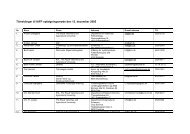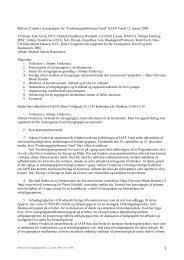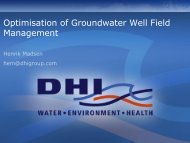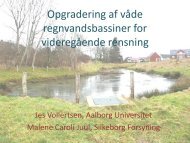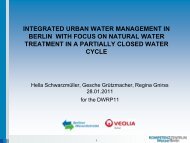Jens Muff, AAU Esbjerg. Examples of an Electrochemical Advanced ...
Jens Muff, AAU Esbjerg. Examples of an Electrochemical Advanced ...
Jens Muff, AAU Esbjerg. Examples of an Electrochemical Advanced ...
You also want an ePaper? Increase the reach of your titles
YUMPU automatically turns print PDFs into web optimized ePapers that Google loves.
<strong>Examples</strong> <strong>of</strong> <strong>an</strong> <strong>Electrochemical</strong><br />
Adv<strong>an</strong>ced Oxidation Process (EAOP) for<br />
degradation <strong>of</strong> pesticides, PAHs <strong>an</strong>d other<br />
recalcitr<strong>an</strong>t org<strong>an</strong>ics in water<br />
<strong>Jens</strong> <strong>Muff</strong><br />
Section <strong>of</strong> Chemical Engineering<br />
Department <strong>of</strong> Biotechnology, Chemistry <strong>an</strong>d Environmental Engineering<br />
Aalborg University<br />
1
Agenda<br />
• EAOP in comparison to other AOPs<br />
• Principle <strong>of</strong> electrochemical oxidation (EO)<br />
• <strong>Examples</strong> <strong>of</strong> applications:<br />
• Case study 1: Høfde 42 (Pesticides)<br />
• Case study 2: Sediment dredging (PAHs)<br />
• Case study 3: Kærgaard (Pharmaceuticals, solvents)<br />
• Concluding remarks <strong>an</strong>d perspectives<br />
2
Adv<strong>an</strong>ced Oxidation Processes (AOPs)<br />
“Aqueous phase oxidation methods intermediated <strong>of</strong> highly reactive species<br />
such as (primarily but not exclusively) hydroxyl radicals in the mech<strong>an</strong>isms<br />
leading to destruction <strong>of</strong> the target pollut<strong>an</strong>ts” 1<br />
AOPs<br />
pollut<strong>an</strong>t<br />
OH CO H O<br />
2 2<br />
inorg<strong>an</strong>ic compounds<br />
<strong>Electrochemical</strong> oxidation!<br />
1<br />
Comninellis et al (2008) J Chem Technol Biotechnol 83:769-776 ; 2 Poyatos et al. (2010) Water Air Soil Pollut, 205, p. 187-204<br />
3
What c<strong>an</strong> they be used for<br />
… matrices that are too diluted to incinerate or too<br />
concentrated or/<strong>an</strong>d toxic to treat biologically<br />
Areas:<br />
• Industrial effluent treatment:<br />
– Distillery, agrochemical, kraft-bleaching, pulp <strong>an</strong>d paper, textile dye-house, oilfield<br />
<strong>an</strong>d metal-plating<br />
• Hazardous effluent treatment:<br />
– Hospitals <strong>an</strong>d slaughterhouses<br />
• Removal <strong>of</strong> pathogens <strong>an</strong>d persistent, endocrine disrupting<br />
pharmaceutical residues from municipal WWTP effluents<br />
• Removal <strong>of</strong> org<strong>an</strong>ic micro-pollut<strong>an</strong>ts such as pesticides from water<br />
Aim: Degradation <strong>of</strong> recalcitr<strong>an</strong>t non-biocompatible org<strong>an</strong>ics:<br />
• Improvement <strong>of</strong> the BOD/COD ratio (partial or full mineralization) in pre-treatment<br />
• Polishing step (tertiary treatment)<br />
• Inactivation or killing <strong>of</strong> microorg<strong>an</strong>isms (disinfection)<br />
Source: Comninellis et al. (2008) J Chem Technol Biotechnol, 83, 769-776<br />
4
EAOP versus other AOPs<br />
Why electrochemical oxidation:<br />
Challenges:<br />
• Environmental compatible technique: use <strong>of</strong> a<br />
“cle<strong>an</strong>” reagent (the electron), no addition <strong>of</strong><br />
excess chemicals, only electricity is required<br />
• Power consumption: Currently, when<br />
optimized for waste water treatment not<br />
below 30 kWh/kg COD removed<br />
• Control <strong>of</strong> reaction rate: Through control <strong>of</strong><br />
applied current. the process c<strong>an</strong> be turned on<br />
<strong>an</strong>d <strong>of</strong>f<br />
• Versatile: non-selective towards a wide r<strong>an</strong>ge<br />
<strong>of</strong> org<strong>an</strong>ic pollut<strong>an</strong>ts<br />
• Less independent <strong>of</strong> temperature: Compared<br />
to chemical oxidation<br />
• Capacity: Expensive with large flow rates<br />
• Corrosion/Damage to electrodes: Long term<br />
stability <strong>an</strong>d fouling cause challenges<br />
• Risk <strong>of</strong> byproduct formation: Byproducts are<br />
formed, <strong>an</strong>d need to be taken into concern<br />
• Amenability to automation: Simple to operate<br />
<strong>an</strong>d automate<br />
Walsh F.C. (2001) Pure <strong>an</strong> applied chemistry, 73, 12, 1819-1837<br />
5
Reaction mech<strong>an</strong>isms in EO<br />
Active oxygen formation<br />
MO + H +<br />
(chemi-sorption)<br />
M( OH) + H +<br />
(physi-sorption)<br />
e -<br />
e -<br />
Direct oxidation<br />
R<br />
R<br />
H 2 O<br />
e -<br />
EOTR*<br />
R<br />
-Pt-Pt-Pt-Pt-Ir-Pt-Pt-Pt-Pt-<br />
ROH / RO<br />
CO 2 + H 2 O<br />
* EOTR = <strong>Electrochemical</strong> oxygen tr<strong>an</strong>sfer reaction (EOTR)<br />
Comninellis, C. (1994) Electrochimica Acta, 39, 1857-1862 ; Bonfatti, F. et al. (2000) Journal <strong>of</strong> the <strong>Electrochemical</strong> Society, 147 (2), 592-596<br />
6
Reaction mech<strong>an</strong>isms in EO<br />
Active oxygen formation<br />
MO + H +<br />
(chemi-sorption)<br />
M( OH) + H +<br />
(physi-sorption)<br />
e -<br />
e -<br />
Direct oxidation<br />
R<br />
R<br />
H 2 O<br />
e -<br />
EOTR*<br />
R<br />
-Pt-Pt-Pt-Pt-Ir-Pt-Pt-Pt-Pt-<br />
ROH / RO<br />
CO 2 + H 2 O<br />
Cl - + M( OH)<br />
e -<br />
M(HOCl) ads<br />
R<br />
CO 2 + H 2 O+ Cl -<br />
e -<br />
Indirect mediated oxidation<br />
2Cl -<br />
Cl -<br />
Cl 2 + H 2 O → HOCl + H + + Cl -<br />
CO 2 + H 2 O<br />
R<br />
* EOTR = <strong>Electrochemical</strong> oxygen tr<strong>an</strong>sfer reaction (EOTR)<br />
Comninellis, C. (1994) Electrochimica Acta, 39, 1857-1862 ; Bonfatti, F. et al. (2000) Journal <strong>of</strong> the <strong>Electrochemical</strong> Society, 147 (2), 592-596<br />
7
Side reactions <strong>an</strong>d <strong>an</strong>ode materials<br />
Primary cathode reaction:<br />
Unw<strong>an</strong>ted side reaction (loss <strong>of</strong> efficiency):<br />
Direct oxidation power:<br />
2H2O 4e H<br />
2<br />
2OH<br />
2H2O O2<br />
4H 4e<br />
-<br />
-<br />
MO M O<br />
1<br />
2<br />
M ( OH ) M O H e<br />
2<br />
1<br />
2<br />
2<br />
Electrode<br />
material<br />
Oxidation potential<br />
/ V<br />
Overpotential <strong>of</strong> O 2<br />
evolution / V<br />
Adsorption<br />
enthalpy <strong>of</strong><br />
MO x ( . OH)<br />
Oxidation power <strong>of</strong><br />
the <strong>an</strong>ode<br />
“Active”<br />
“Non-active”<br />
RuO 2 -TiO 2 1.4-1.7 0.18<br />
IrO 2 -Ta 2 O 5 1.5-1.8 0.25<br />
Ti/Pt 1.7-1.9 0.3<br />
Ti/PbO 2 1.8-2.0 0.5<br />
Ti/SnO 2 -Sb 2 O 5 1.9-2.2 0.7<br />
p-Si/BDD 2.2-2.6 1.3<br />
Chemisorption <strong>of</strong><br />
OH radical<br />
Physisorption <strong>of</strong><br />
OH radical<br />
Si/BDD: Full mineralization<br />
Ti/Pt: Partial mineralization<br />
Kapalka et al. (2008) Journal <strong>of</strong> Applied Electrochemistry, 38, 7-16<br />
8
Case study 1: Høfde 42 (Pesticides)<br />
1953–1962:<br />
Deposition <strong>of</strong> primarily pesticides in the s<strong>an</strong>d dunes<br />
near Høfde 42<br />
1981:<br />
Excavation <strong>of</strong> 1200 tons <strong>of</strong> chemicals, 120 tons were<br />
left behind.<br />
2006:<br />
Installation <strong>of</strong> 600 m <strong>of</strong> sheet piles => immobilization<br />
<strong>of</strong> the pollution (ca. 98%)<br />
2007–2008:<br />
Pilot scale study: Alkaline hydrolysis <strong>an</strong>d biological<br />
degradation<br />
2010-13:<br />
Alkaline hydrolysis demonstration project with tests <strong>of</strong><br />
different enh<strong>an</strong>cement methods (NorthPestCle<strong>an</strong>)<br />
Parathion<br />
Malathion<br />
Source: Google Earth<br />
9
Case study 1: Høfde 42 (Pesticides)<br />
COD<br />
Overall oxidation<br />
Specific compounds<br />
Parent pesticides<br />
Degradation products<br />
J. <strong>Muff</strong>, et al. (2009), Electrochim. Acta, 54, 2062-2068<br />
10
Case study 1: Høfde 42 (Pesticides)<br />
• Efficient for degradation <strong>of</strong> the target pollut<strong>an</strong>ts<br />
• Non-polar byproducts not present<br />
– Substitute gr<strong>an</strong>ulated active carbon adsorption<br />
– Need to check for other byproducts<br />
• Indirect treatment possible<br />
– Possible in-situ soil treatment (ISCO)<br />
– Re-infiltration <strong>of</strong> EC oxid<strong>an</strong>t<br />
Intermixing approach (1:1)<br />
EC<br />
J. <strong>Muff</strong>, et al. (2009), Electrochim. Acta, 54, 2062-2068<br />
11
Case study 2: Sediment dredging (PAHs)<br />
Dredging <strong>of</strong> sediment from harbours to maintain sail ch<strong>an</strong>nels.<br />
Chemicals <strong>of</strong> concern:<br />
• Polycyclic aromatic hydrocarbons (PAHs)<br />
• Tri-butyl-tin (TBT)<br />
PAHs:<br />
Sources<br />
• Incomplete combustion <strong>of</strong> carbon sources (fossil<br />
fuel, diesel, cigarettes, wood stoves)<br />
Hum<strong>an</strong> health effects<br />
• Highly toxic, carcinogenic, mutagenic<br />
Threshold value (drinking water)<br />
• 0.010 – 0.005 µg L -1<br />
Characteristics<br />
• Multiple ring structures, lipophilic <strong>an</strong>d hence low<br />
water solubility, persistent, recalcitr<strong>an</strong>t, <strong>an</strong>d nonreactive<br />
12
Case study 2: Sediment dredging (PAHs)<br />
Process water from harbour<br />
sediment dredging<br />
Direct EO treatment<br />
Treatment cost:<br />
• 13.2 kWh m -3<br />
Intermixing approach<br />
Treatment cost:<br />
• 19 kWh m -3<br />
Naphthalene, pyrene <strong>an</strong>d fluor<strong>an</strong>thene<br />
J. <strong>Muff</strong> <strong>an</strong>d E. Søgaard (2010) Water Science <strong>an</strong>d Technology, 61.8, pp. 2043-2051<br />
13
Case study 3: Kærgaard Pl<strong>an</strong>tation<br />
(Pharmaceuticals)<br />
Kærgaard Pl<strong>an</strong>tation: Chemical waste <strong>an</strong>d waste water<br />
from Grindstedværket<br />
Contamin<strong>an</strong>ts: sulfonamides, barbiturates, <strong>an</strong>iline, pyridine,<br />
chlorinated solvents, mercury, cy<strong>an</strong>ide, BTEX amo.<br />
14
Case study 3: Kærgaard Pl<strong>an</strong>tation<br />
(Pharmaceuticals)<br />
Groundwater samples from hot spot in pit 1 (13.6- 14.3 m bgs). Prior to use in the<br />
experiment, the water was bubbled with atmospheric air to remove VOC <strong>an</strong>d org<strong>an</strong>ics<br />
easily oxidized.<br />
COD vs. Q (specific charge)<br />
TOC vs. Q (specific charge)<br />
J. <strong>Muff</strong>, H. Jepsen <strong>an</strong>d E. Søgaard (2011) Submitted<br />
15
<strong>Electrochemical</strong> oxidation<br />
• Powerful oxidation technique <strong>of</strong> toxic, bioincompatible<br />
org<strong>an</strong>ic pollut<strong>an</strong>ts<br />
– Org<strong>an</strong>o-phosphoric pesticides<br />
– PAHs<br />
– Pharmaceutical waste<br />
Concluding remarks<br />
• Attention is needed concerning byproducts<br />
– Prolonged reaction times, evaluate overall parameters<br />
– Work needed to decrease power consumption<br />
16
Acknowledgements<br />
• Co-authors <strong>an</strong>d colleagues<br />
• Watersafe DK Aps by Niels Erik Skjærbæk<br />
• Zheshen Li, Aarhus University<br />
• Students:<br />
– Rasmus <strong>an</strong>d Christi<strong>an</strong><br />
– Gunhild, Henrik <strong>an</strong>d Søren<br />
– Henrik<br />
– Hülia <strong>an</strong>d Carina<br />
17





